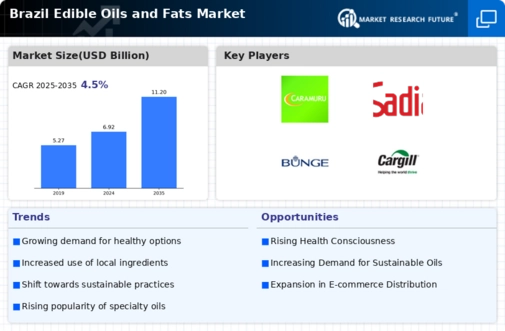Rising Consumer Awareness
In Brazil, there is a notable increase in consumer awareness regarding health and nutrition, which significantly impacts the edible oils-fats market. As individuals become more informed about the health implications of dietary fats, they are increasingly opting for oils that are perceived as healthier options. This shift is reflected in the growing demand for oils rich in unsaturated fats, such as olive and canola oils. According to recent data, the consumption of these oils has risen by approximately 15% over the past year. This trend suggests that consumers are willing to pay a premium for products that align with their health-conscious choices, thereby driving growth in the edible oils-fats market. Furthermore, this heightened awareness is likely to influence product innovation and marketing strategies within the industry.
Sustainability Initiatives
Sustainability has emerged as a pivotal concern within the edible oils-fats market in Brazil. Consumers are increasingly favoring products that are produced through environmentally friendly practices. This shift is prompting manufacturers to adopt sustainable sourcing and production methods, particularly for palm and soy oils. Recent statistics suggest that approximately 25% of consumers are willing to pay more for sustainably sourced oils. This trend indicates a potential for growth in the market as companies that prioritize sustainability may gain a competitive edge. Furthermore, regulatory bodies are beginning to implement guidelines that encourage sustainable practices, which could further influence the dynamics of the edible oils-fats market. As sustainability becomes a core value for consumers, the industry may need to adapt to meet these expectations.
Increased Use in Food Service
The food service sector in Brazil is experiencing a surge in the use of various edible oils and fats, which is a crucial driver for the edible oils-fats market. Restaurants and catering services are increasingly incorporating diverse oils into their cooking processes to enhance flavor and meet consumer preferences. Data indicates that the food service industry accounts for nearly 40% of total oil consumption in Brazil. This trend is likely to continue as establishments seek to differentiate their offerings and cater to evolving culinary trends. Additionally, the rise of food delivery services has further amplified the demand for oils that can withstand high cooking temperatures, such as palm and soybean oils. This growing reliance on edible oils in food preparation is expected to bolster the market's expansion.
Growing Demand for Functional Oils
The demand for functional oils in Brazil is on the rise, driven by consumers seeking products that offer health benefits beyond basic nutrition. Oils enriched with omega-3 fatty acids, antioxidants, and vitamins are gaining popularity, particularly among health-conscious individuals. This trend is reflected in the increasing availability of specialty oils in retail outlets, which cater to specific dietary needs. Recent market analysis indicates that functional oils could account for up to 20% of the total edible oils-fats market by 2026. This growing segment suggests that consumers are not only looking for cooking oils but also for products that contribute to overall wellness. As the market evolves, manufacturers may need to focus on developing and marketing functional oils to meet this emerging demand.
Technological Advancements in Production
Technological advancements are playing a crucial role in shaping the edible oils-fats market in Brazil. Innovations in extraction and refining processes are enhancing the quality and yield of oils, thereby meeting the increasing demand for high-quality products. For instance, the adoption of cold-pressing techniques has gained traction, allowing for the production of oils that retain more nutrients and flavor. This technological evolution is likely to attract health-conscious consumers, thereby expanding the market. Additionally, advancements in packaging technology are improving the shelf life and convenience of edible oils, further driving consumer interest. As these technologies continue to evolve, they may significantly influence the competitive landscape of the edible oils-fats market.















Leave a Comment